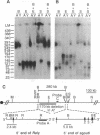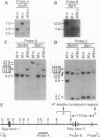Abstract
Lethal yellow (Ay) is a mutation at the mouse agouti locus in chromosome 2 that causes a number of dominant pleiotropic effects, including a completely yellow coat color, obesity, an insulin-resistant type II diabetic condition, and an increased propensity to develop a variety of spontaneous and induced tumors. Additionally, homozygosity for Ay results in preimplantation lethality, which terminates development by the blastocyst stage. The Ay mutation is the result of a 170-kb deletion that removes all but the promoter and noncoding first exon of another gene called Raly, which lies in the same transcriptional orientation as agouti and maps 280 kb proximal to the 3' end of the agouti gene. We present a model for the structure of the Ay allele that can explain the dominant pleiotropic effects associated with this mutation, as well as the recessive lethality, which is unrelated to the agouti gene.
Full text
PDF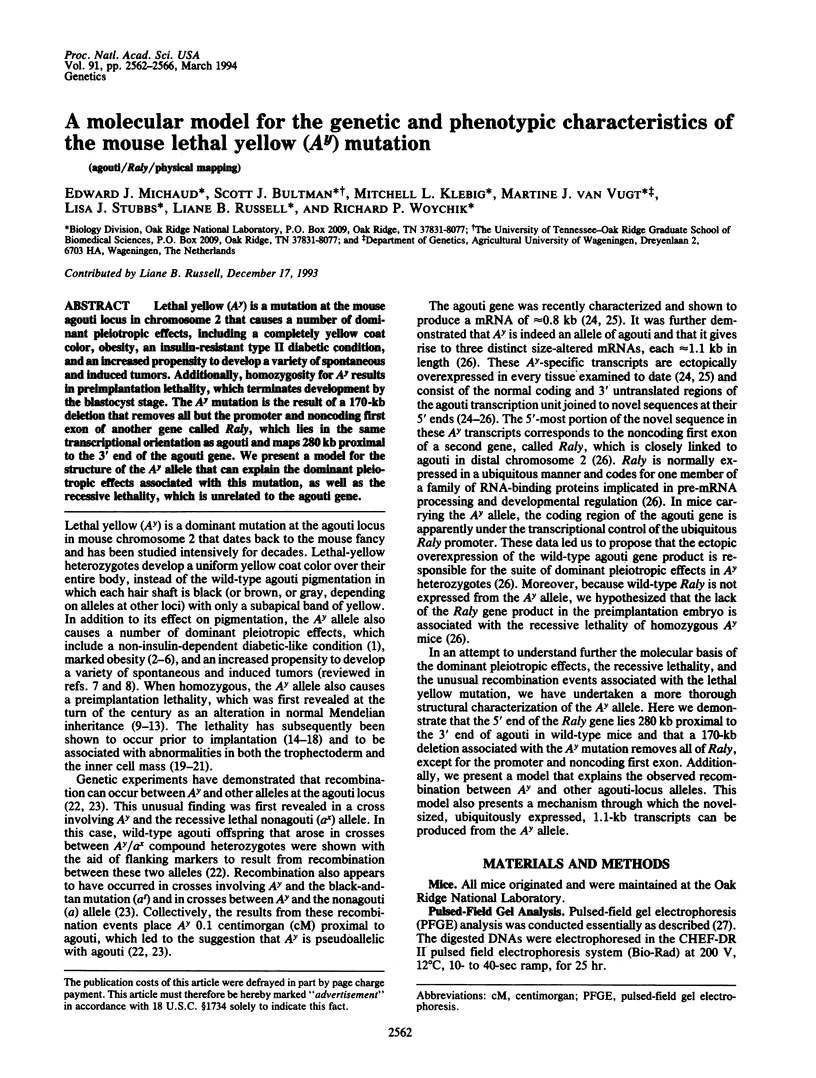
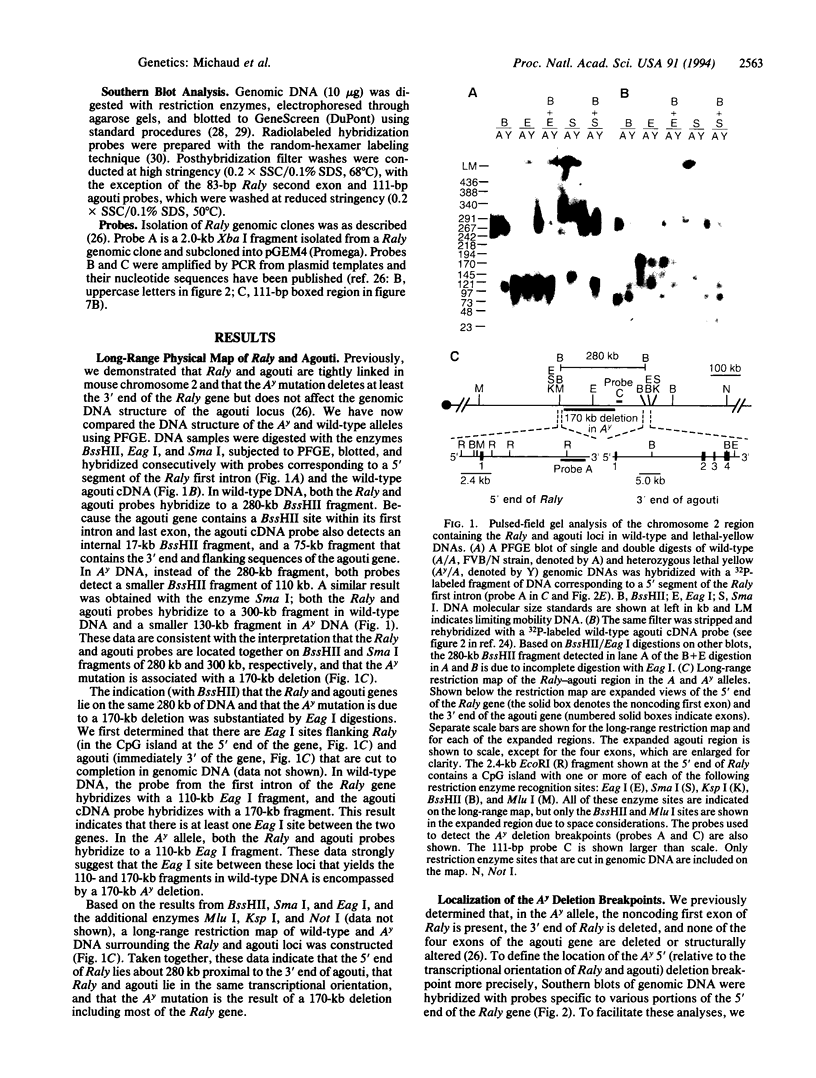
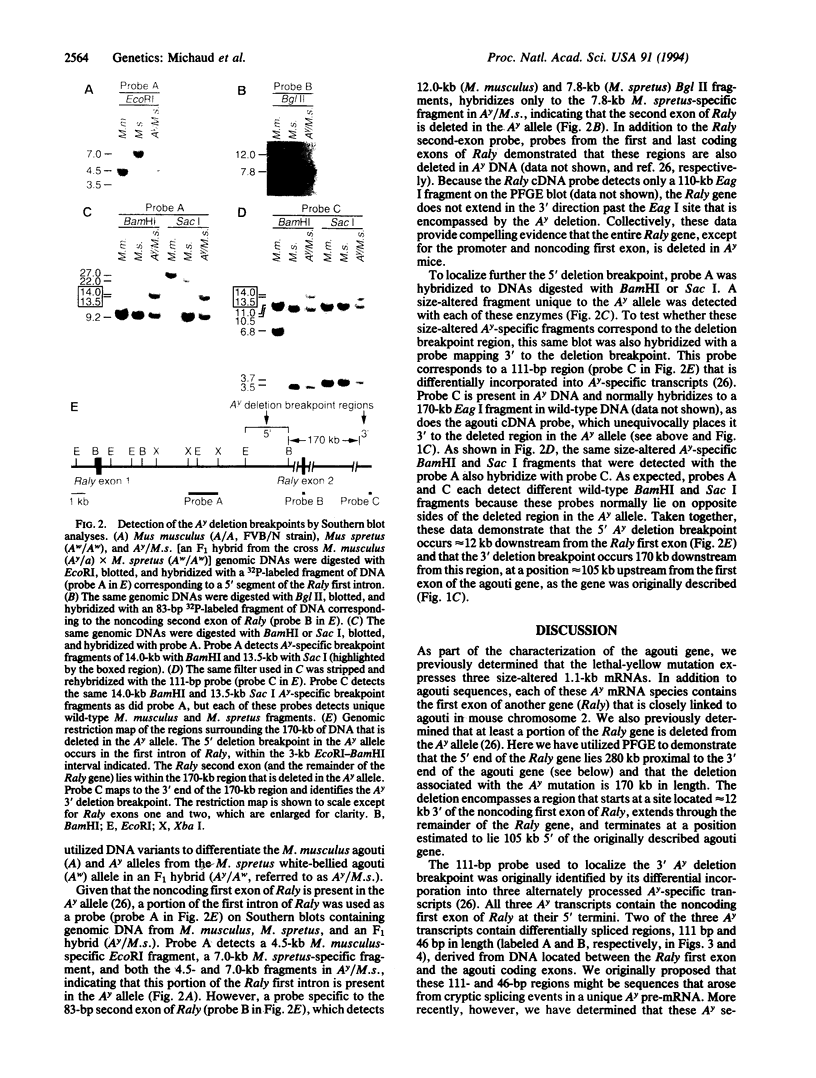
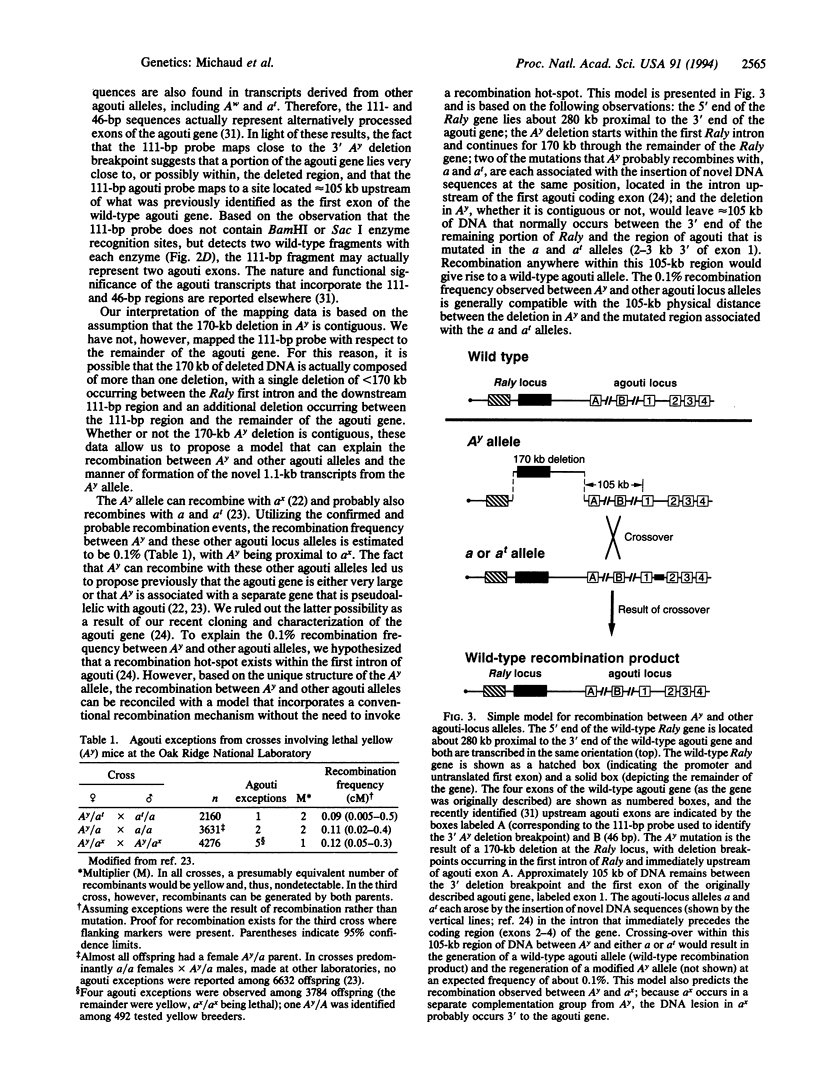
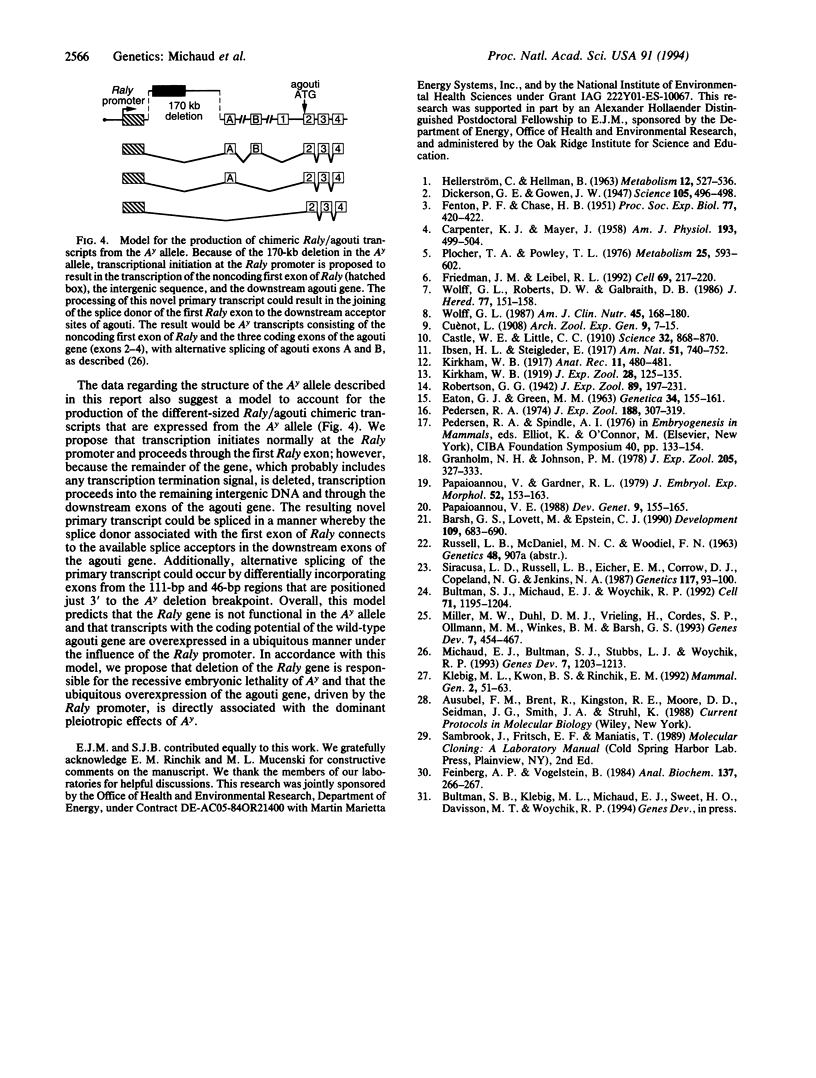
Images in this article
Selected References
These references are in PubMed. This may not be the complete list of references from this article.
- Barsh G. S., Lovett M., Epstein C. J. Effects of the lethal yellow (Ay) mutation in mouse aggregation chimeras. Development. 1990 Jul;109(3):683–690. doi: 10.1242/dev.109.3.683. [DOI] [PubMed] [Google Scholar]
- Bultman S. J., Michaud E. J., Woychik R. P. Molecular characterization of the mouse agouti locus. Cell. 1992 Dec 24;71(7):1195–1204. doi: 10.1016/s0092-8674(05)80067-4. [DOI] [PubMed] [Google Scholar]
- CARPENTER K. J., MAYER J. Physiologic observations on yellow obesity in the mouse. Am J Physiol. 1958 Jun;193(3):499–504. doi: 10.1152/ajplegacy.1958.193.3.499. [DOI] [PubMed] [Google Scholar]
- Castle W. E., Little C. C. ON A MODIFIED MENDELIAN RATIO AMONG YELLOW MICE. Science. 1910 Dec 16;32(833):868–870. doi: 10.1126/science.32.833.868. [DOI] [PubMed] [Google Scholar]
- Dickerson G. E., Gowen J. W. Hereditary Obesity and Efficient Food Utilization in Mice. Science. 1947 May 9;105(2732):496–498. doi: 10.1126/science.105.2732.496-a. [DOI] [PubMed] [Google Scholar]
- FENTON P. F., CHASE H. B. Effect of diet on obesity of yellow mice in inbred lines. Proc Soc Exp Biol Med. 1951 Jul;77(3):420–422. doi: 10.3181/00379727-77-18800. [DOI] [PubMed] [Google Scholar]
- Feinberg A. P., Vogelstein B. "A technique for radiolabeling DNA restriction endonuclease fragments to high specific activity". Addendum. Anal Biochem. 1984 Feb;137(1):266–267. doi: 10.1016/0003-2697(84)90381-6. [DOI] [PubMed] [Google Scholar]
- Friedman J. M., Leibel R. L. Tackling a weighty problem. Cell. 1992 Apr 17;69(2):217–220. doi: 10.1016/0092-8674(92)90402-x. [DOI] [PubMed] [Google Scholar]
- Granholm N. H., Johnson P. M. Enhanced identification of lethal yellow (Ay/Ay) mouse embryos by means of delayed development of four-cell stages. J Exp Zool. 1978 Aug;205(2):327–333. doi: 10.1002/jez.1402050218. [DOI] [PubMed] [Google Scholar]
- HELLERSTROM C., HELLMAN B. The Islets of Langerhans in yellow obese mice. Metabolism. 1963 Jun;12:527–536. [PubMed] [Google Scholar]
- Klebig M. L., Kwon B. S., Rinchik E. M. Physical analysis of murine albino deletions that disrupt liver-specific gene regulation or mesoderm development. Mamm Genome. 1992;2(1):51–63. doi: 10.1007/BF00570440. [DOI] [PubMed] [Google Scholar]
- Michaud E. J., Bultman S. J., Stubbs L. J., Woychik R. P. The embryonic lethality of homozygous lethal yellow mice (Ay/Ay) is associated with the disruption of a novel RNA-binding protein. Genes Dev. 1993 Jul;7(7A):1203–1213. doi: 10.1101/gad.7.7a.1203. [DOI] [PubMed] [Google Scholar]
- Miller M. W., Duhl D. M., Vrieling H., Cordes S. P., Ollmann M. M., Winkes B. M., Barsh G. S. Cloning of the mouse agouti gene predicts a secreted protein ubiquitously expressed in mice carrying the lethal yellow mutation. Genes Dev. 1993 Mar;7(3):454–467. doi: 10.1101/gad.7.3.454. [DOI] [PubMed] [Google Scholar]
- Papaioannou V. E. Investigation of the tissue specificity of the lethal yellow (Ay) gene in mouse embryos. Dev Genet. 1988;9(3):155–165. doi: 10.1002/dvg.1020090302. [DOI] [PubMed] [Google Scholar]
- Papaioannou V., Gardner R. L. Investigation of the lethal yellow Ay/Ay embryo using mouse chimaeras. J Embryol Exp Morphol. 1979 Aug;52:153–163. [PubMed] [Google Scholar]
- Pedersen R. A. Development of lethal yellow (Ay-Ay) mouse embryos in vitro. J Exp Zool. 1974 Jun;188(3):307–320. doi: 10.1002/jez.1401880307. [DOI] [PubMed] [Google Scholar]
- Plocher T. A., Powley T. L. Effect of hypophysectomy on weight gain and body composition in the genetically obese yellow (Ay/a) mouse. Metabolism. 1976 May;25(5):593–602. doi: 10.1016/0026-0495(76)90013-5. [DOI] [PubMed] [Google Scholar]
- Siracusa L. D., Russell L. B., Eicher E. M., Corrow D. J., Copeland N. G., Jenkins N. A. Genetic organization of the agouti region of the mouse. Genetics. 1987 Sep;117(1):93–100. doi: 10.1093/genetics/117.1.93. [DOI] [PMC free article] [PubMed] [Google Scholar]
- Wolff G. L. Body weight and cancer. Am J Clin Nutr. 1987 Jan;45(1 Suppl):168–180. doi: 10.1093/ajcn/45.1.168. [DOI] [PubMed] [Google Scholar]
- Wolff G. L., Roberts D. W., Galbraith D. B. Prenatal determination of obesity, tumor susceptibility, and coat color pattern in viable yellow (Avy/a) mice. The yellow mouse syndrome. J Hered. 1986 May-Jun;77(3):151–158. doi: 10.1093/oxfordjournals.jhered.a110206. [DOI] [PubMed] [Google Scholar]



